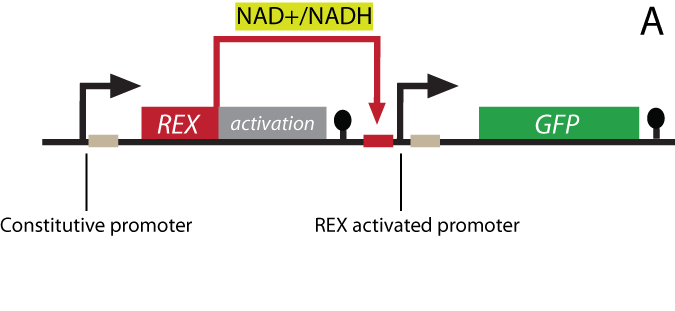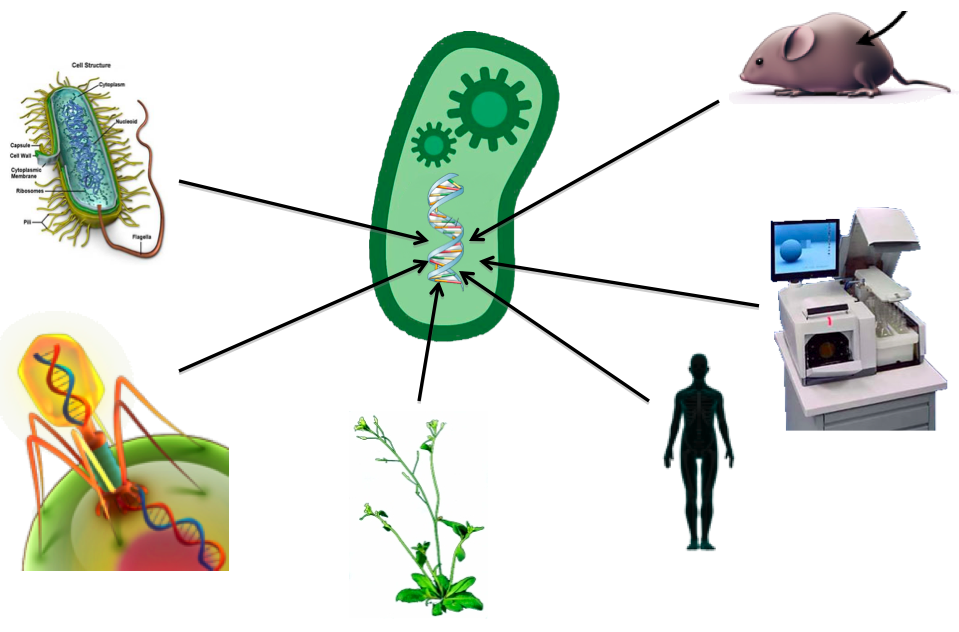Team:DTU Denmark/genetic design
From 2009.igem.org

| Home | The Team | The Project | Parts submitted | Modelling | Notebook |
|
- Applications and perspectives - Safety considerations
- Instructions - Output format
|
The project Genetic design We have designed and physically constructed a genetic system that couples the intracellular NAD+/NADH level to the gene expression of a reporter protein. The system has potentially many applications including in vivo online monitoring of the redox poise, production optimization and cancer research with yeast as a model organism (see Applications). The NAD+/NADH ratio is sensed by a system originating in Streptomyces coellicolor. In S. coellicolor the protein REX is a repressor and controls the gene expression of multiple genes by recognizing and binding to a specific DNA-sequence termed ROP (Rex operator). NAD+ and NADH compete to associate with Rex, but only a REX:NAD+ association can bind the ROP DNA-sequence (Brekasis and Paget, 2003). In S. coellicolor REX DNA binding represses expression of target genes, by physically hindering RNA-polymerases from binding the promoter. As the transcription machinery of eukaryotes is different and more complicated, there are no guarantee that repression will be effective in eukaryotes. REX has therefore been fused to an eukaryotic transcriptional activator, a widely used technique applied for the investigation of the GAL proteins and other systems (Sadowski et al. 1988). The REX-activator fusion-protein is able to bind the ROB sequence placed upstream of a minimal eukaryotic promoter that only supports transcription upon activation. A certain NAD+/NADH ratio will activate the Redoxilator to recognize the ROB promoter, resulting in transcription of the reporter gene.
Gene design and redox regulation Design specifications
The genetic elements and the requirements they need to fulfill are listed in the following table. The detailed description of the used genetic elements will not be made publicly available due to IP rights. The elements have been selected solely on their properties, and are from a variety of organisms - several of them are biobricks. All elements are codon optimized for S. cerevisiae
Modelling Design and submission of a biobrick allowing fast degradation of any protein Description and requirements of the genetic elements
References |
Why yeast? The utilization of improved micro-organisms for industrial processes is a fact for centuries. From the early stages in the preparation of fermented food and beverages until nowadays. Recent advances in biochemistry, engineering and genetic manipulation techniques, led scientist and engineers to improve micro-organisms in order to enhance their metabolic capabilities for biotechnological applications. Along with these improvements, a far more rational and direct approach to strain improvement have been employed, of what we call Metabolic Engineering. What distinguishes Metabolic Engineering from the classical approaches is the application of advanced analytical tools for identification of suited targets for genetic modifications or even the use of mathematical models to perform in silico design of optimized micro-organisms. The consequences of the changes introduced in these engineered strains can then suggest further modifications to improve cellular performance and therefore Metabolic Engineering can be seen as a cyclic process made of continuous iterations between experimental and analytical work. |
| Comments or questions to the team? Please Email us -- Comments of questions to webmaster? Please Email us |
 "
"




